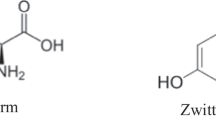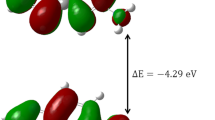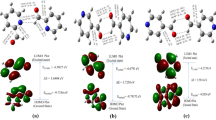Abstract
Using the quantum mechanic procedure with the DFT/BLYP method, the structures and properties of tyrosine (Tyr) and its oxidation derivatives (DOPA and DOPA-Quinone) were theoretically investigated. For these three molecules, geometry optimizations, electric charges distribution at the atomic level, thermodynamic parameters and frontier orbital energies were obtained. Compared with DOPA-Quinone, Tyr and DOPA have higher chemical reactivities and tend to participate in the electrophilic substitution reaction. Moreover, the thermodynamic calculations show that no matter at the low, normal or high temperature, the oxidation reactions of Tyr and DOPA are exothermic, and their ∆ G are always less than 0, suggesting that these two compounds are easily oxidized. Finally, the calculation of frontier orbital energies indicates that the stability of Tyr is similar to that of DOPA, and among the three, DOPA-Quinone is the most stable one.
Access this chapter
Tax calculation will be finalised at checkout
Purchases are for personal use only
Preview
Unable to display preview. Download preview PDF.
Similar content being viewed by others
References
Fan, Y., Flurkey, W.H.: Purification and characterization of tyrosinase from gill tissue of Portabella mushrooms. Phytochemistry 65(6), 671–678 (2004)
Wang, Y.J., Fu, J., Liu, N.: Important Biological Material-Melanin and Mechanism of Function. Amino Acids and Biological Resources 25(1), 12–14 (2003)
Ou, Z.M., Wang, P., Wang, H.: The Process of Application Research of Tyrosinase. Chinese Bioengineering Journal, 163–169 (2005)
Green, K., Berdecia, R., Cheeks, L.: Mussel adhesive protein permeability characteristics when used as a basement membrane. Curr. Eye Res. 6(6), 835–838 (1987)
Yu, M.E., Hwang, J.Y., Deming, T.: Role of dihydroxyphenylalanine in Mussel Adhesive Proteins. J. Am. Chem. Soc. 121(24), 5825–5826 (1999)
Haemers, S., et al.: Cross-linking and multilayer adsorption of mussel adhesive proteins. Langmuir 18(12), 4903–4907 (2002)
Rodríguez-López, J.N., Fenoll, L.G., Peñalver, M.J., et al.: Tyrosinase action on monophenols: evidence for direct enzymatic release of o-diphenol. Biochimica et Biophysica Acta (BBA)-Protein Structure and Molecular Enzymology 1548(2), 238–256 (2001)
Wang, D.X., Dong, X.R., Wang, S.J.: The DFT calculation of structures and stabilities of metal sulfide CoSx. Journal of Molecular Science 23(2), 129–134 (2007)
Lv, Z.B., Zhuang, L.H., Tian, Y.W., Wang, D.L.: Investigation of flavonoide compounds with density functional theory. Journal of Molecular Science 23(5), 354–357
Delley, B.: An all-electron numerical method for solving the local density functional for polyatomie molecules. J. Chem. Phys. 92(1), 508–517 (1990)
Delley, B.J.: From molecules to solids with the Dmola approach. Chem. Phys. 113(18), 7756–7764 (2000)
Yang, P., Gao, X.H.: Function-Structure-Bond. High Education Press, Beijing (1987)
Author information
Authors and Affiliations
Editor information
Editors and Affiliations
Rights and permissions
Copyright information
© 2009 Springer-Verlag Berlin Heidelberg
About this paper
Cite this paper
Huang, Wz., Xie, Zm., Chen, Sk., Li, D. (2009). Optimizing the Properties of Tyrosine and It’s Oxidation Derivatives Based on Quantum Computation. In: Cao, B., Li, TF., Zhang, CY. (eds) Fuzzy Information and Engineering Volume 2. Advances in Intelligent and Soft Computing, vol 62. Springer, Berlin, Heidelberg. https://doi.org/10.1007/978-3-642-03664-4_102
Download citation
DOI: https://doi.org/10.1007/978-3-642-03664-4_102
Publisher Name: Springer, Berlin, Heidelberg
Print ISBN: 978-3-642-03663-7
Online ISBN: 978-3-642-03664-4
eBook Packages: EngineeringEngineering (R0)




